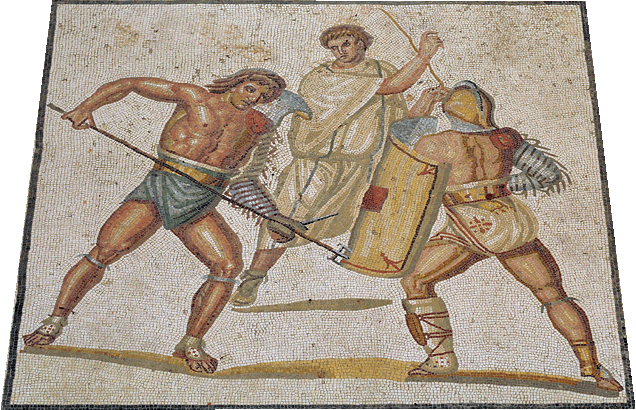
The traditional opponent of the retiarius was the secutor or "chaser," so named, says Isidore of Seville (Etymologies, XVIII.55), because he pursued the retiarius. Also called a contraretiarius, this was the class in which Commodus fought, and one wonders whether he deliberately competed against his lightly armed opponent so that, like Claudius, "he could watch their faces as they died" (Suetonius, Life of Claudius, XXXIV.1).
The secutor wears the loincloth and wide belt of the retiarius and his right arm (rather than the left) is protected by a manica, a wrapping of heavy linen tied with leather thongs. To protect against the trident, the secutor also has a greave (ocrea) on his left leg (the one that was placed forward in combat), and carries a curved rectangular shield (scutum) and sword (gladius). But it is the helmet that most readily distinguishes him.
The terrible symmetry of gladiatorial combat can best be appreciated in this pairing. The strategy was for the secutor to attack his opponent, using the shield for protection. The retiarius, on the other hand, tried to keep his distance so he could swing his net and use the trident effectively, thrusting at both the head and legs of his pursuer. Unless the secutor could strike quickly, there was a danger of exhaustion from the heavier armor and, more importantly, the helmet's constriction on breathing. If the retiarius could entangle the secutor or manage to close with his adversary, there was the chance to use the dagger, which can be seen in his left hand. Isidore, too, comments on the pairing: the retiarius is dedicated to Neptune and the secutor to Vulcan— because fire pursues, and water and fire always are adversaries.
In this beautiful third century AD mosaic, the retiarius strikes at the secutor. The referee (summa rudis, from the rod, rudis, that he carried) looks on. The mosaic is in the museum at Römische Villa Nennig.
References: The Colosseum (2000) edited by Ada Gabucci; The Etymologies of Isidore of Seville (2006) by Stephen A. Barney, W. J. Lewis, J. A. Beach, and Oliver Berghof.